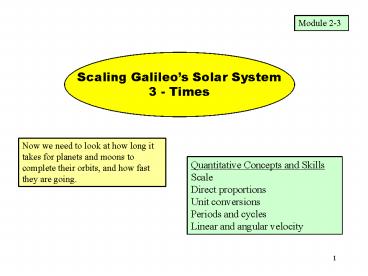Module 23 PowerPoint PPT Presentation
1 / 14
Title: Module 23
1
Module 2-3
Scaling Galileos Solar System 3 - Times
Now we need to look at how long it takes for
planets and moons to complete their orbits, and
how fast they are going.
Quantitative Concepts and Skills Scale Direct
proportions Unit conversions Periods and
cycles Linear and angular velocity
2
PREVIEW
The alumni do not want just a static model of the
solar system. Rather, their donation is for a
working scale model -- where the globes
(including the sand-sized ones) can be seen to
move around in their various orbits. They like
this idea because students would then get a feel
for the passage of time in the solar system (this
module) and how interplanetary distances vary
with time (next module). We will scale the
times so that Galileos outermost planet makes a
complete round trip in 1 day. That 1 day
compares to 29 years for the real Saturn to
orbit the sun. So, with that scaling factor,
what are the periods of the other planets and
moons in Galileos system? What will the speeds
be? Slide 4 scales the times. Slides 5 and
6 add the linear velocities, and Slides 7 and 8
introduce and calculate angular velocities.
Slides 9 and 10 calculate periods and velocities
of the five moons in Galileos system. Slides
11-13 compare cycles of the moons to those of
their planets.
Your cell equations will need to include factors
to convert time intervals from one unit to
another. Among the conversions you might need to
use (and remember) are 1 yr 365.25
days 1 day 24 hr 1 hr 60 min
1 min 60 sec
3
Retrieve this data sheet again. This time we
will be using Columns F and G.
4
Scaling the time
1. Calculate E16 from C and D, and G16 from
E16. 2. Calculate E17 from E14 and F14. Then
calculate F9F13 and G17 from E17.
Columns C and D are from Modules 2-1 and 2-2.
Column E is from data slide.
We are scaling the model so that Saturn tracks
around the campus in one day.
5
Scaling the time, 2
Now work out the velocities. For the prototype
planets, calculate H from C and E, and I from H.
For the model planets, calculate J from D and G,
and K from J. You will need to use the formula
for the circumference of a circle.
As a check, you can also calculate K from D and F
6
Scaling the time, 3
Side Exercise What is the scale for the
velocity? Calculate your answer in two different
ways.
In the Copernican system, outer planets move more
slowly than inner planets. This was a major
point in Copernicuss argument against the
Aristotelian system.
7
The velocities of Slide 6 are linear velocities,
the traveled distance divided by the elapsed
time. Units for linear velocities are km/yr,
ft/day, mi/hr, among others. Angular velocity
(this slide) is the angle swept out per unit
time. Angular velocity is stated in units such
as cycles/yr, radians/hr, degrees/min, among
others.
Angular velocities
For the prototype planets calculate E from C, and
F and G from E. For the model planets, calculate
H from D, and I and J from H. You will need to
use the number of radians per cycle, and the
number of degrees per cycle.
Columns C and D are from previous slide.
8
Angular velocities, 2
Side exercise What is the scale for the angular
velocities? How does this compare to the scale
for the times?
9
So far you have calculated the velocities of the
planets around the sun (assumed stationary). You
can easily calculate the velocity of the moons
around their planets (assumed stationary).
Adding the moons
Columns C and E are from your data sheet
Rows 11 and 14 are from previous spreadsheets,
but calculate them again to the third significant
digit using the scales in E4 and E5. Then go on
and complete the velocities for the moons.
10
Adding the moons, 2
Notice how fast those moons of Jupiter are going?
In the scale model, for example, it takes a
little less than a minute for Io to make four
cycles around Jupiter, In the same time, Jupiter
moves a bit more than four meters.
11
Moon cycles and planet cycles
How many times does a moon go around its planet
in the time that it takes for the planet to go
around the sun?
Calculate D again from C and the scale in E4.
Then calculate E from row data.
12
Moon cycles and planet cycles, 2
Now calculate the moon-to-planet ratio of angular
velocities. Calculate G from C, and H from D (or
alternatively, H from C and E4). Then calculate
I from the row data in G or H.
13
Moon cycles and planet cycles, 3
Side exercise Explain why Columns E and I contain
the same results.
14
End of Module Assignments
- Do the three side exercises..
- Add Uranus, Neptune and Pluto to the spreadsheets
of Slides 6 and 8. - Add Uranus, Neptune, Pluto and the moons of
Saturn, Uranus, Neptune and Pluto to the
spreadsheets of Slides 10 and 12. - The linear velocities of the moons you calculated
in Slide 9 were relative to the planets that they
circle. The velocities of the moons relative to
the ground in the model would be something
different. How would you calculate them? - According to Cell E11 of Slide 12, our moon makes
13.38 cycles in the time that it takes our planet
to circle the sun. Does this mean that we have
13.38 full moons in a year? The answer is no.
Look into the difference between sidereal and
synodic periods. The periods that are relevant
to the model are sidereal periods. Why?

